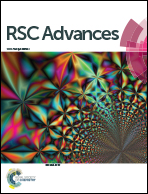Efficient and “green” fabrication of pH-responsive poly(methacrylic acid) nano-hydrogels in water
Abstract
Due to the water solubility of their component polymers, hydrophilic nano-hydrogels are usually fabricated in organic media, which causes environmental and toxicity issues. In this study, by the combined use of an ionic/nonionic surfactant mixture, a hydrophobic initiator and a poly(methyl methacrylate) (PMMA) nanolatex seed, a novel emulsion polymerization method was developed for the “green” synthesis of poly(methacrylic acid) (PMAA) nano-hydrogels in water at a high concentration (50 g L−1). The method includes two steps. First, PMMA nanolatex seeds stabilized by sodium dodecylsulfate (SDS) were formed in situ. Second, MAA was selectively polymerized on the surfaces of the PMMA nanoparticles with the help of the nonionic surfactant Tween 20, resulting in PMAA nano-hydrogels with cores of PMMA and cross-linked shells of PMAA. The core–shell structure of the PMAA nano-hydrogels was confirmed by TEM observations. The size and swelling capacity of the nano-hydrogels can be facilely adjusted: as the amount of crosslinker is decreased, the concentration of Tween 20 is increased, the concentration of MAA is increased, or MAA is fed in one batch instead of semi-continuously, both the size and swelling capacity of the nano-hydrogels increase. The PMAA nano-hydrogels also display excellent pH response: as the pH value increases from 1 to 6, the hydrodynamic volume of the hydrogels expands 64-fold. Finally, this new method is expected to be extended to the “green” synthesis of other nano-hydrogels such as poly(acrylic acid) and polyacrylamide nano-hydrogels.


 Please wait while we load your content...
Please wait while we load your content...